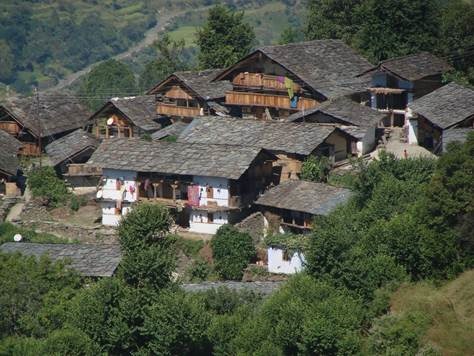~ A Direct initiative of help for the village folk of Dharali beyond Uttarkashi by the team of Ibex Expeditions and its friends ~
Over the years, the village of Garhwal has been close to us along with its simple village folk who have been friends of Ibex Expeditions, being hired as porters, cooks, and guides, apart from earning a fair livelihood from their fields and crop.
Today, they no longer have a livelihood, and the danger of losing their homes looms large ahead. The Himalayan Tsunami of June 2013 came unexpectedly in the areas of Uttarakhand, and has so far claimed a flood devastation of over 6000 lives and hundreds of small villages.
Fortunately, there was no loss of life in Dharali as the town residents escaped their homes, taking shelter in caves close to the village.
However, with roads broken and washed away, the 500 village community of Dharali is close to worse times, with food reserves depleted and damage insurmountable. The Dharali village has lost its crop and orchards, as well as the guest houses that brought in an income.
The traumas they have experienced are inconceivable.
In a simple, yet effective, initiative, the Ibex Expeditions team have decided to help this one village restore themselves by supplying what they need most at the moment: food and rations.
As you would know, Dharali is a village that lies 18kms short of Gangotri and the road is broken at at least 3 places between Uttarkashi and Dharali. Our plan is to purchase rations like rice, sugar, flour, tea, pulses that are most required, and hire porters to ferry them to reach them effectively and directly.
We have given the responsibility to our Chief Guide, Khem Singh Panwar, along with the husband of the village Pradhan, Bhagwat Singh, who will travel to Uttarkashi, purchase food items. Along with porters, they will travel 5 Kms in a vehicle to Gangotri, walk from Gangotri to Sainj for 10-12 Kms, then from Sainj in a Jeep to Bhatwari for 6 Kms, the trek 10 Kms from Bhatwari to to Gangani, and from Gangani to Dabrani in a Jeep for 12 Kms with one breach in between, and finally walk 20 Kms from Dabrani to Dharali. Khem Singh will oversee the entire effort and send detailed accounts, bills of food purchased, porter fees, intermittent transport charges, and the final distribution at Dharali village via the Gram Panchayat (village head) to the community which will be documented and photographed.
We are very grateful to those kind souls who have already rapidly reached out with generous donations to the relief process. We will inform each donor of where and how the money was use. A lot of past clients and friends who have traveled in India have come forward to help in many ways.
A Traumatized Village that Can't Sleep
Pankaj Doval, TNN: June 28, 2013, 06:28 IST
DHARALI (Last village on the Sino-Indian Border in Uttarkashi): For people here, life's been a nightmare ever since flash floods hit Uttarakhand.
When the skies open up now, people of this remote village run to the dark and treacherous mountain caves and spend uncertain hours there. The village, on the the Gangotri pilgrimage route, is home to 500-600 people and was hit hard by flash floods on June 16.
The devastation was massive. Small houses were destroyed and hotels went down. An army officer described the horror: "We came to know that Dharali had been impacted, we rushed there. We found the area was devastated, not a soul was around. We shuddered at the thought that all the villagers had been washed away by the Bhagirathi. But, soon we got to know that they had taken refuge in the caves."
Dharali gets snow for six months, and many villagers move to Uttarkashi during this time. A stream that flows along Dharali swelled into a mighty river after the rains came. It now threatens to wash the village away. The villagers are scared. "We live in danger and can't sleep at night. The moment we hear thunder, we run and take shelter in the caves," Savita, in her early forties, says.
Donations to be sent to: Ibex Expeditions P Ltd., 30 Community Centre, East of Kailash, New Delhi 110065, INDIA.















